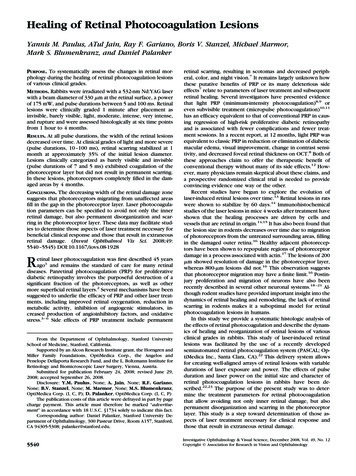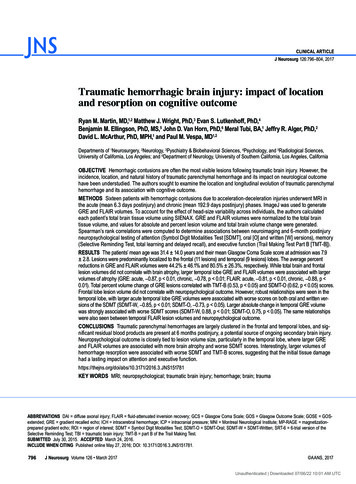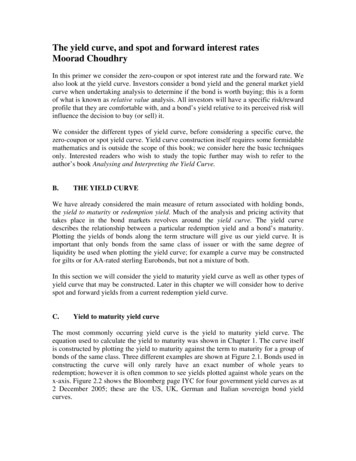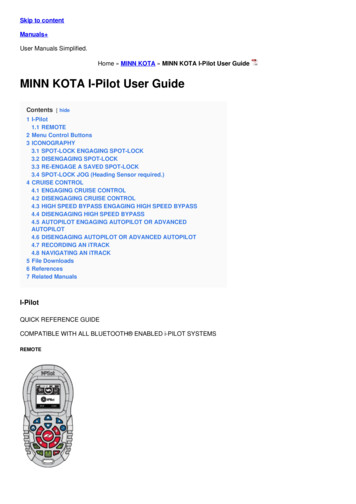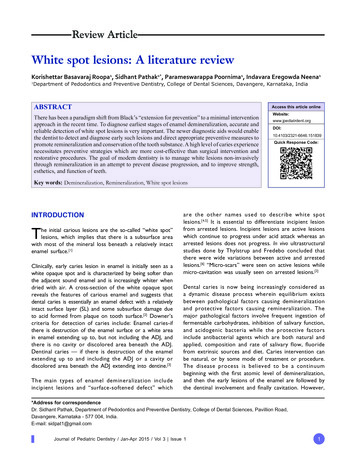
Transcription
Review ArticleWhite spot lesions: A literature reviewKorishettar Basavaraj Roopa1, Sidhant Pathak1*, Parameswarappa Poornima1, Indavara Eregowda Neena1Department of Pedodontics and Preventive Dentistry, College of Dental Sciences, Davangere, Karnataka, India1ABSTRACTAccess this article onlineThere has been a paradigm shift from Black’s “extension for prevention” to a minimal interventionapproach in the recent time. To diagnose earliest stages of enamel demineralization, accurate andreliable detection of white spot lesions is very important. The newer diagnostic aids would enablethe dentist to detect and diagnose early such lesions and direct appropriate preventive measures topromote remineralization and conservation of the tooth substance. A high level of caries experiencenecessitates preventive strategies which are more cost-effective than surgical intervention andrestorative procedures. The goal of modern dentistry is to manage white lesions non-invasivelythrough remineralization in an attempt to prevent disease progression, and to improve strength,esthetics, and function of -6646.151839Quick Response Code:Key words: Demineralization, Remineralization, White spot lesionsINTRODUCTIONThe initial carious lesions are the so-called “white spot”lesions, which implies that there is a subsurface areawith most of the mineral loss beneath a relatively intactenamel surface.[1]Clinically, early caries lesion in enamel is initially seen as awhite opaque spot and is characterized by being softer thanthe adjacent sound enamel and is increasingly whiter whendried with air. A cross-section of the white opaque spotreveals the features of carious enamel and suggests thatdental caries is essentially an enamel defect with a relativelyintact surface layer (SL) and some subsurface damage dueto acid formed from plaque on tooth surface.[2] Downer’scriteria for detection of caries include: Enamel caries-ifthere is destruction of the enamel surface or a white areain enamel extending up to, but not including the ADJ, andthere is no cavity or discolored area beneath the ADJ.Dentinal caries — if there is destruction of the enamelextending up to and including the ADJ or a cavity ordiscolored area beneath the ADJ extending into dentine.[3]The main types of enamel demineralization includeincipient lesions and “surface-softened defect” whichare the other names used to describe white spotlesions.[4,5] It is essential to differentiate incipient lesionfrom arrested lesions. Incipient lesions are active lesionswhich continue to progress under acid attack whereas anarrested lesions does not progress. In vivo ultrastructuralstudies done by Thylstrup and Fredebo concluded thatthere were wide variations between active and arrestedlesions.[6] “Micro-scars” were seen on active lesions whilemicro-cavitation was usually seen on arrested lesions.[2]Dental caries is now being increasingly considered asa dynamic disease process wherein equilibrium existsbetween pathological factors causing demineralizationand protective factors causing remineralization. Themajor pathological factors involve frequent ingestion offermentable carbohydrates, inhibition of salivary function,and acidogenic bacteria while the protective factorsinclude antibacterial agents which are both natural andapplied, composition and rate of salivary flow, fluoridefrom extrinsic sources and diet. Caries intervention canbe natural, or by some mode of treatment or procedure.The disease process is believed to be a continuumbeginning with the first atomic level of demineralization,and then the early lesions of the enamel are followed bythe dentinal involvement and finally cavitation. However,*Address for correspondenceDr. Sidhant Pathak, Department of Pedodontics and Preventive Dentistry, College of Dental Sciences, Pavillion Road,Davangere, Karnataka - 577 004, India.E-mail: sidpat1@gmail.comJournal of Pediatric Dentistry / Jan-Apr 2015 / Vol 3 Issue 11
Roopa, et al.: White spot lesionsthe early lesion is known to remineralize and is, therefore,regarded as reversible.[7]SUBSURFACE WHITE SPOT LESIONFORMATIONThe caries process takes place slowly which requiresrepeated episodes of prolonged exposure to acidicconditions consistently below the critical pH for enameldissolution (pH 5.5, demineralization) with interveningperiods of return to the resting pH of plaque (pH 7.0,remineralization period).[8-11] In case of failure to removeplaque from retentive tooth areas, a diet rich in refinedcarbohydrates, and frequent carbohydrate ingestion,the dynamic equilibrium between demineralization andremineralization will be tipped toward demineralizationwith the development of clinically detectable white spotlesions. The early enamel lesion is characterized byfour distinct histopathologic zones. [12,13] Two zones ofdemineralization are present:1. The translucent zone (1% pore volume) along theadvancing front of the lesion; and2. The body of the lesion ( 5-25% pore volume)representing the majority of the lesion and situatedapproximately 15-30 μm beneath the overlying intactenamel surface.Two zones of remineralization are also present:1. The dark zone (2-4% pore volume) situated nearthe advancing front just superficial to the translucentzone; and2. The surface zone (1 to 5% pore volume) formingthe intact surface overlying the lesion.The initial formation of the lesion is due to the dissolutionof hydroxyapatite (HAP) from the enamel prisms formingthe enamel surface.[8,12,13]The initial dissolution results in the loss of a small amountof mineral within the enamel and would have a similarappearance to the translucent zone (negative birefringencein quinoline). With continuing demineralization without thebenefit of remineralization of this initial lesion, a surfacezone that resembles the surrounding sound enamel, withrespect to its negative birefringence (water imbibition)is formed. With ongoing removal of mineral from theunderlying enamel, a positively birefringent body of thelesion (water imbibition) develops and separates theoverlying surface zone from the translucent zone at theadvancing front. If lesion development occurs over arelatively long period, a zone of remineralization (the darkzone, positive birefringence in quinoline) with reciprocationof mineral phases from the translucent zone will occur. Iflesion formation is over a short period of time, the darkzone will not form and there will be rapid advancement2of the front with a large, heavily demineralized body ofthe lesion and a surface zone of minimum thickness. Oncea certain degree of demineralization has occurred thelesion will take on a white spot appearance and becomeclinically detectable. The maintenance of an intact surfaceduring caries formation is quite remarkable. At first, thiswas considered to be unique to surface enamel. Later, itwas proven that an intact surface can be reproduced evenwhen the surface enamel is ground away, and artificialcaries is created in the remaining abraded enamel.The subsurface white spot lesion with an intact surfaceoccurs due to the physicochemical parameters ofdemineralization of HAP. The mechanistic approach todemineralization of enamel is based upon the primarydriving force being hydrogen ion transport from thedental plaque at a pH of 5.0 into the underlying enamelat a pH of 7.0. The concentration gradient for hydrogenis much less in enamel than that in dental plaque,during episodes of acidogenesis by mutans streptococciand lactobacilli. Hydrogen ions are transported tothe advancing front of the lesion. Once the hydrogenions encounter susceptible tooth mineral, dental HAPundergoes dissolution with the resultant dissolvedmineral transported from the advancing front to thedental plaque. Of interest is the fact that the fluid phaseat the advancing front has a much lower calcium andphosphate concentration (0.1 mmol/L) than that at theenamel surface (5-8 mmol/L). This implies that calciumand phosphate are being transported against theirconcentration gradient, and this requires energy input toaccomplish this. The energy for this active transport ofsolubilized mineral phase from the advancing caries frontis supplied by the influx of the hydrogen ions driven by a100 fold concentration gradient. In the plaque comparedwith enamel along the advancing front. Mineral phasesmay become entrapped in the zones of remineralizationif the caries process is a slow process. During theintervening periods of remineralization and return toa resting neutral plaque pH, partially demineralizedcrystals may be repaired, or new crystals formed fromthe available dissolved mineral phases within the lesionand dental plaque. Demineralization may be markedlydecreased in individuals with high plaque levels of calcium,phosphate, and fluoride. The increased calcium andphosphate in plaque would require a lower pH betweenplaque and the advancing front to allow for activetransport of calcium and phosphate from the advancingcaries front into the plaque. This effectively would resultin a lower critical pH in order to induce demineralization.The presence of increased levels of fluoride in plaquefavors reprecipitation of dissolved mineral and also allowsfor the incorporation of fluoride into reconstituted HAP.Likewise, increased fluoride content of native enamel inthe form of fluoro-hydroxyapatite would lessen the extentof demineralization and favor mineral reprecipitation.[14]Journal of Pediatric Dentistry / Jan-Apr 2015 / Vol 3 Issue 1
Roopa, et al.: White spot lesionsDETECTION OF WHITE SPOT LESIONSOver the last two decades, there has been a drasticchange in the prevalence and pattern of dental carieswith a decrease in smooth surfaces caries and withmore lesions being detected on the occlusal surfacesof the tooth. Thus, it is important to identify earlyand institute preventive measures for the control ofdental caries. The traditional methods of detectingearly lesions include visual inspection and radiography.In visual observation, reflected light is used to detectchanges in color, texture, and translucency of the toothsubstance. However, these traditional methods for earlycaries diagnosis have been found to be inaccurate andinsensitive. Unfortunately, radiographs have the addedrisk of exposure of ionizing radiation to the patient.[3]As the present-day caries lesion progresses slowly,it is advisable to have a method which misses someof the shallow lesions, but yet has a high positivepredictive value for deeper lesions. [2] It is hard todiagnose occlusal caries in teeth without a macroscopicbreakdown of the outer enamel surface. [15] Enamelapproximal caries lesions are poorly detected byradiography since demineralization in excess of 40%must occur for the radiographic detection to be possiblealthough dentinal lesions in occlusal surfaces may bedetected with some accuracy.[16,17] In a study by Yassinon in vitro mechanical damage of early carious lesion(enamel lesion) in artificial U-shaped grooves causedby a sharp dental explorer, it was seen that whena force of 500 g was used there was no damage tothe sound enamel grooves. However, the probingby a sharp dental explorer in demineralized enamelgrooves resulted in cavitation of white spot lesion withapparently a sound SL. The dentist should, therefore,be cautious while using a sharp dental explorer toexamine early carious lesions in pits and fissures.[18] Thenewer available methods for caries detection includeauto-fluorescence (such as quantitative light-inducedfluorescence [QLF]) of teeth, electrical resistance (suchas ECM), and imaging techniques like conventionaland digital bitewing radiography. [19] Transillumination,DIAGNOdent, and DIFOTI devices comprise the othersupplemental methods to aid in the diagnosis. [20] QLFwhich measures enamel autofluorescence can detectdifferences in remineralization of early enamel caries.[21]A new fiberoptic diagnostic tool enabling dentists toidentify early caries lesions with greater sensitivity andspecificity is the fibre-optics-based confocal imagingsystem which can record axial profiles through carieslesions using single-mode optical fibers. [22] A noveltechnology involving optical coherence tomography(OCT) imaging of tooth which shows greater lightbackscattering intensity at sites of carious lesions thanthe sound enamel could be used for screening carioussites and determining lesion depth, in combinationwith Raman spectroscopy for biochemical confirmationof caries. [23] Polarization-sensitive optical coherencetomography (PSOCT) system has also been used tostudy the spatially resolved scattering and polarizationphenomena of teeth which are known to have strongpolarization effect. PSOCT is another tool that has beenused for in vitro dental caries assessment of remineralizedlesions.[24] Digital Imaging Fiber-Optic Transillumination(DIFOTI) uses images of teeth obtained with a digitalCCD camera, which are sent to a computer for analysiswith dedicated algorithms for location and diagnosis ofcarious lesions by the operator in real time, therebyproviding a quantitative characterization for monitoringof approximal, occlusal, and smooth-surface caries. [25]Frequency-domain photothermal radiometry (FD-PTRor PTR) and modulated luminescence have also beenused to detect early interproximal demineralized lesions.However, PTR provides more accurate diagnosis thanthe modulated luminescence.[26] Laser fluorescence deviceDIAGNOdent has been used to detect occlusal cariesand has more sensitivity and specificity than radiographicexamination.[27] In a study on Digital Imaging Fiber-OpticTrans-Illumination (DIFOTI), F-speed radiographic film,and depth of approximal lesions, it was observed thatthe histologic lesion depth determined by F-speedradiographic film was identical to that evaluated bypolarized light microscopy while DIFOTI did not measurethe depth. However, DIFOTI could detect surfacechanges associated with early demineralization as earlyas 2 weeks. The investigators of this study suggestedthat surgical or chemical treatment strategies shouldtake into account cavitation rather than histologiclesion depth.[28] Data evaluating the accuracy of enameldemineralization detection using conventional, digital,and digitized radiographs, and evaluation of radiographsand logarithmically contrast-enhanced subtraction imagesshow that Den-Optix system represents the advancesin the development of photostimulable phosphor platesand is a plausible alternative to conventional radiographs.It was observed that radiographs taken with InSight filmwere cheap and accurate and that digital subtractionenhanced approximal enamel caries lesion detection.[16]According to Gimenez et al. fluorescence-based methodshad similar accuracy in detecting occlusal and approximalcaries lesions, on both primary and permanent teeth,and they performed better in detecting more advancedcaries lesions.[29] Gomez et al. concluded that electricalconductance (EC) and QLF seemed to be promising forthe detection of early lesions. Visual methods remainedthe goal standard for clinical assessment in dentalpractice keeping in mind both cost and practicalityconsiderations.[30] Twetman et al. reported in his studythat electrical methods and laser fluorescence couldbe useful adjuncts to visual-tactile and radiographicexaminations, especially on occlusal surfaces in permanentand primary molars.[31]Journal of Pediatric Dentistry / Jan-Apr 2015 / Vol 3 Issue 13
Roopa, et al.: White spot lesionsCHARACTERISTICS OF WHITE SPOTLESIONS IN ENAMELThe enamel demineralization defect has a lower mineraldistribution in the SL in comparison to the adjacentsound enamel and also a lower interprismatic mineralcontent. The first stage of enamel demineralization ischaracterized by removal of interprismatic mineral contentand in the subsequent stages a well-defined SL formationoccurs which constitutes early caries lesion. [2] Thesestudies have demonstrated that a porous and mineralrich SL covers an enamel lesion and the morphologydiffers a little from that of sound enamel while body ofthe lesion which comprises the subsurface area has lowmineral content (10-70 vol.%). The early caries lesionin enamel is characterized by a prominent perikymatapattern and focal holes.[32-34] The main drawback of thenumerous experimental techniques is that they are staticmeasurements of caries progression at a particular timeperiod whereas the carious process is time-dependentand is in a constant state of dynamic equilibrium whereina balance is struck between demineralization andremineralization.SURFACE LAYER COVERING WHITESPOT LESIONSThe early investigators who observed the white opaquespots attributed the presence of these lesions to artifacts.They believed that the SL could be due to sound enamelwhich has a higher mineral content. These explanationswere proved false by subsequent investigations byLangdon et al. [35] Their studies on pressed pellets ofHAP demonstrated that subsurface lesion could occurin an acidic gel system with 2 ppm fluoride. They alsoconcluded that organic matrix is not important forsubsurface lesion formation, and that neither a preferredcrystallite orientation in the enamel prisms nor an unevenion/mineral distribution in enamel were essential for theformation of a subsurface lesion since these are absent inpressed apatites. This is in contrast to earlier reports byBrudevold et al.[36]REMINERALIZING AGENTS FORTREATMENT OF WHITE SPOT LESIONSComplex of casein phosphopeptides-amorphouscalcium phosphateComplex of casein phosphopeptides-amorphous calciumphosphate (CPP-ACP) is an acronym for a CPPs andACP. Caseins are a heterogeneous family of proteinspredominated by alpha 1 and 2 and b-caseins. CPPs arephosphorylated casein-derived peptides produced bytryptic digestion of casein.4The CPP containing the amino acid cluster sequence - Ser(P)-Ser (P)-Ser (P)-Glu-Glu has the ability to bind andstabilize calcium and phosphate in solution, as well asto bind dental plaque and tooth enamel. Through theirmultiple phosphoryl residues, the CPPs bind to formclusters of ACP in metastable solution, preventing theirgrowth to the critical size required for nucleation andprecipitation. The proposed mechanism of anticariogenicityfor the CPP-ACP is that it localizes ACP in dental plaque,which buffers the free calcium and phosphate ion activities,thereby helping to maintain a state of supersaturation withrespect to tooth enamel depressing demineralization andenhancing remineralization. The CPPs have been shownto keep fluoride ions in solution, thereby enhancing theefficacy of the fluoride as a remineralizing agent.[37,38]Complex of casein phosphopeptides inhibits adherenceof oral bacteria to saliva-coated hydroxyapatite beads(S-HA). By selectively inhibiting the streptococcal adhesionto teeth, it can modulate the microbial composition ofdental plaque and favor establishment of less cariogenicspecies such as oral actinomyces. This could also controlacid formation (buffering) in dental plaque, in turn reducingHAP dissolution from tooth enamel.[39,40]It can be incorporated into the pellicle in exchange foralbumin and thus inhibits the adherence of Streptrococcusmutans and Streptococcus sobrinus, causing bothneutralization and enhancement of remineralization.[41]The Recaldent Technology was developed by Prof. EricReynolds of the University of Melbourne. CPP-ACP hasbeen trademarked Recaldent and has been launched insugarless chewing gum and confectionery. More recently,a sugar-free, water-based cream containing RECALDENT (CPP-ACP) (GC Tooth Mousse/Prospec MI Paste) hasbeen made available to dental professionals.[42]Azarpazhooh and Limeback concluded that the long-termeffectiveness of CPP-ACP in preventing caries in vivo isunknown due to lack of clinical trial evidence.[43]Amorphous calcium phosphateThe ACP technology requires a two-phase delivery systemto keep the calcium and phosphorous components fromreacting with each other before use. The current sourcesof calcium and phosphorous are two salts, calcium sulfateand dipotassium phosphate. When the two salts aremixed, they rapidly form ACP that can precipitate ontothe tooth surface. This precipitated ACP can then readilydissolve into the saliva and can be available for toothremineralization.[44]It can be considered a useful adjuvant for the controlof caries in orthodontic applications. Experimental ACPJournal of Pediatric Dentistry / Jan-Apr 2015 / Vol 3 Issue 1
Roopa, et al.: White spot lesionscomposite has shown to efficiently establish mineral iontransfer throughout the body of the lesion and restorethe mineral lost due to acid attack.[45]The ACP technology was developed by Dr. Ming S. Tung.In 1999, ACP was incorporated into toothpaste calledEnamelon and later reintroduced in 2004 in Enamel Caretoothpaste by Church and Dwight. It is also available asDiscus Dental’s Nite White Bleaching Gel and PremierDental’s Enamel Pro Polishing Paste. It is also used in theAegis product line, such as Aegis Pit and Fissure Sealant,produced by Bosworth.[46]Sodium calciumphosphosilicate (bioactive glass)When bioactive glass comes in contact with saliva, itrapidly releases sodium, calcium, and phosphorous ionsinto the saliva that are available for remineralization of thetooth surface. The ions released form hydroxycarbonateapatite (HCA) directly. They also attach to the toothsurface and continue to release ions and remineralize thetooth surface after the initial application. These particleshave been shown to release ions and transform intoHCA for up to 2 weeks. Ultimately, these particles willcompletely transform into HCA.[47]Novamin adheres to exposed dentin surface and forms amineralized layer that is mechanically strong and resistantto acid. There is a continuous release of calcium overtime, which maintains the protective effects on dentin.[48]The NovaMin Technology was developed by Dr. LenLitkowski and Dr. Gary Hack. Currently, available productsin the market are NovaMin: SootheRx, DenShield,NuCare-Root Conditioner with NovaMin, NuCareProphylaxis Paste with NovaMin, and Oravive.[49,50]Calcium carbonate carrier-SensiStatThe SensiStat technology is made of arginine bicarbonate,an amino acid complex, and particles of calcium carbonate,a common abrasive in toothpaste. The arginine complexis responsible for adhering the calcium carbonate particlesto the dentin or enamel surface and allows the calciumcarbonate to dissolve slowly and release calcium that isthen available to remineralize the tooth surface.[51]The SensiStat Technology was developed by Dr. IsraelKleinberg of New York. The technology was firstincorporated into Ortek’s Proclude desensitizing prophypaste and later in Denclude.[52]increase in plaque pH and salivary buffering capacity preventsthe demineralization of tooth structure. Moreover, thehigher concentration of calcium, phosphate, and hydroxylions in such saliva also enhances remineralization.[53]Miake et al. observed that xylitol can induceremineralization of deeper layers of demineralized enamelby facilitating Ca2 movement and accessibility.[54]Nano-hydroxyapatiteA study was done to determine the effect of nano-HAPconcentrations on initial enamel lesions under dynamicpH-cycling conditions. It was concluded that nano-HAPhad the potential to remineralize initial enamel lesions.A concentration of 10% nano-HAP may be optimal forremineralization of early enamel caries.[55]The trimetaphosphate ionThe potential mode of action of trimetaphosphate ion(TMP) is likely to involve in adsorption of the agentto the enamel surface, causing a barrier coating that iseffective in preventing or retarding reactions of the crystalsurface with its fluid environment, and hence reducingdemineralization during acid challenge.[56]Gu et al. highlighted the role of sodium TMP as atemplating analog of dentin matrix phosphoproteinsfor inducing intrafibrillar remineralization of apatitenanocrystals within the collagen matrix of incompletelyresin infiltrated dentin.[57]Alpha-tricalcium phosphateIt is used in products such as Cerasorb, Bio-Resorb,and Biovision. Tricalcium phosphate (TCP) has also beenconsidered as one possible means for enhancing the levelsof calcium in plaque and saliva. Some small effects on freecalcium and phosphate levels in plaque fluid and in salivahave been found when an experimental gum with 2.5%alpha-TCP by weight was chewed, when compared to acontrol gum without added TCP.[58]Dicalcium phosphate dihydrateInclusion of dicalcium phosphate dehydrate (DCPD) ina dentifrice increases the levels of free calcium ions inplaque fluid, and these remain elevated for up to 12 h afterbrushing, when compared to conventional silica dentifrices.[59]Xylitol carrierCalcium from DCPD was incorporated into enamel anddetected in plaque 18 h post-treatment after brushing witha DCPD dentifrice which fosters improved remineralizationof teeth in combination with fluoride.[60]The use of chewing gum carrying xylitol increases salivaryflow rate and enhances the protective properties of saliva.This is because the concentration of bicarbonate andphosphate is higher in stimulated saliva, and the resultantThe reaction of DCPD and fluoride forming fluorapatitemay provide a potentially promising treatment forremineralization of caries lesions in vivo.[61]Journal of Pediatric Dentistry / Jan-Apr 2015 / Vol 3 Issue 15
Roopa, et al.: White spot lesionsCONCLUSIONThe dynamic balance between demineralization andremineralization determines the progression of whitespot lesion. The diagnostic armamentarium includes noveltechnologies and non-invasive techniques like fiber-optictransillumination and electrical resistance methods whichare very useful in detecting posterior approximal dentinalcaries and occlusal caries. Radiographs and direct digitalimaging are still important tools in estimation of caries. Aclear understanding of the mechanism of subsurface lesionformation and progression, possibilities, and limitationsof newer methods and their clinical applications needto be recognized by the dentist to direct preventivestrategies to the high caries risk individuals. The emphasiscurrently is being given to new technologies for enamelremineralization which suggest the changes in theunderstanding of dental caries. Recent investigations haveprimarily focused on various calcium phosphate-basedtechnologies which are designed to supplement andenhance fluoride’s ability to restore tooth .15.616.17.18.19.20.21.22.23.24.Toumba DC. Diagnosis and prevention of dental caries. In: Welbury R,Duggal MS, Hosey MT, editors. Paediatric Dentistry. 3rd ed. UK: OxfordUniv Press; 2005. p. 109.Arends J, Christoffersen J. The nature of early caries lesions in enamel. JDent Res 1986;65:2-11.Ashley PF, Blinkhorn AS, Davies RM. Occlusal caries diagnosis: Anin vitro histological validation of the Electronic Caries Monitor (ECM) andother methods. J Dent 1998;26:83-8.Koulourides T, Feagin F, Pigman W. Remineralization of dental enamelby saliva in vitro. Ann N Y Acad Sci 1965;131:751-7.Schweizer-Hirt CM, Schait A, Schmid R, Imfeld T, Lutz F,Mühlemann HR. Erosion and abrasion of the dental enamel. Experimentalstudy. SSO Schweiz Monatsschr Zahnheilkd 1978;88:497-529.Thylstrup A, Fredebo L. A method for studying surface coatings and theunderlying features in SEM. In: Frank RM, Leach SA, editors. Surface andColloid Phenomena in the Oral Cavity. Oxford: IRL Press; 1982. p. 169-84.Featherstone JD. The continuum of dental caries — evidence for adynamic disease process. J Dent Res 2004;83 Spec No C:C39-42.Zero DT. Dental caries process. Dent Clin North Am 1999;43:635-64.Fejerskov O. Concepts of dental caries and their consequences forunderstanding the disease. Community Dent Oral Epidemiol 1997;25:5-12.Walsh LJ. Preventive dentistry for the general dental practitioner. AustDent J 2000;45:76-82.Featherstone JD. The science and practice of caries prevention. J Am DentAssoc 2000;131:887-99.Silverstone LM, Hicks MJ, Featherstone MJ. Dynamic factors affectinglesion initiation and progression in human dental enamel. II. Surfacemorphology of sound enamel and carieslike lesions of enamel.Quintessence Int 1988;19:773-85.Silverstone LM, Hicks MJ, Featherstone MJ. Dynamic factors affectinglesion initiation and progression in human dental enamel. Part I. Thedynamic nature of enamel caries. Quintessence Int 1988;19:683-711.Hicks J, Garcia-Godoy F, Flai C. Biological factors in dental caries: Roleof saliva and dental plaque in the dynamic process of demineralizationand remineralization (part 1). J Clin Pediatr Dent 2003;28:47-52.Wenzel A, Verdonschot EH, Truin GJ, König KG. Accuracy of visualinspection, fiber-optic transillumination, and various radiographic image25.26.27.28.29.30.31.32.33.34.35.modalities for the detection of occlusal caries in extracted non-cavitatedteeth. J Dent Res 1992;71:1934-7.Ferreira RI, Haiter-Neto F, Tabchoury CP, de Paiva GA, Bóscolo FN.Assessment of enamel demineralization using conventional, digital, anddigitized radiography. Braz Oral Res 2006;20:114-9.Hin e H, Wenzel A, Jones C. In vitro comparison of D-and E-speed filmradiography, RVG, and visualix digital radiography for the detectionof enamel approximal and dentinal occlusal caries lesions. Caries Res1994;28:363-7.Yassin OM. In vitro studies of the effect of a dental explorer onthe formation of an artificial carious lesion. ASDC J Dent Child1995;62:111-7.Pretty IA. Caries detection and diagnosis: Novel technologies. J Dent2006;34:727-39.Yang J, Dutra V. Utility of radiology, laser fluorescence, andtransillumination. Dent Clin North Am 2005;49:739-52, vi.Feng Y, Yin W, Hu D, Zhang YP, Ellwood RP, Pre y IA. Assessment ofautofluorescence to detect the remineralization capabilities of sodiumfluoride, monofluorophosphate and non-fluoride dentifrices. A single-blindcluster randomized trial. Caries Res 2007;41:358-64.Rousseau C, Poland S
White spot lesions 2 Journal of Pediatric Dentistry / Jan-Apr 2015 / Vol 3 Issue 1 the early lesion is known to remineralize and is, therefore, regarded as reversible.[7] SUBSURFACE WHITE SPOT LESION FORMATION The caries process takes place slowly which requires repeated episodes of prolonged exposure to acidic

